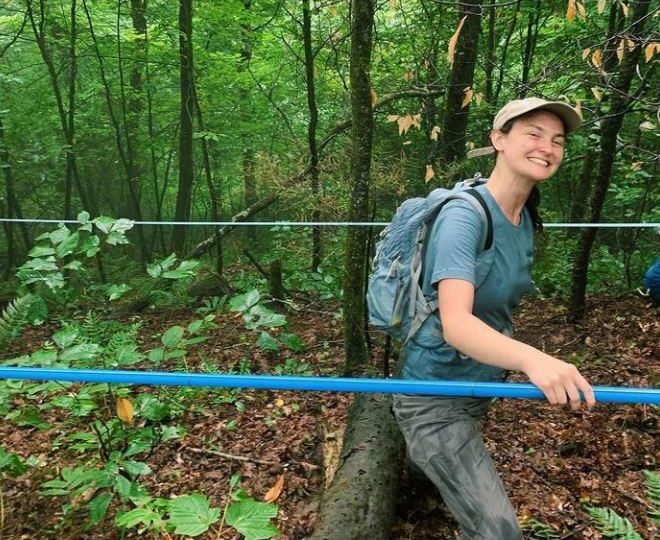
Me in my summer’s natural habitat (a sugarbush). © Rebecca Ross
As the Alexander Dickey Conservation Intern, I was fortunate to try my hand at several of VCE’s ongoing projects. This was basically my dream job and, after I was hired for the position last year only to have it cancelled by COVID-19, I was ecstatic and lucky that I got to try again. My summer was a whirlwind of vignettes on conservation, and it swelled and fizzled with the sun over a backdrop of greens and blues as all good summers do. Here’s some of what I was up to:
Bird-friendly Maple Project
What do you see when you look into the woods on a bright summer day? A homogenous swath of green, a diverse matrix of woody vegetation, the flash of a thrush, the stumble of a toad, beauty, danger, freedom, or home? Working on the Bird-friendly Maple Efficacy Study taught me to see forests as a series of questions begging to be answered.
I spent most of my summer working on this project. Many days found me hiking through sugarbushes across Northern Vermont, collecting data on forest structure, arthropod biomass, and bird diversity. Bird-friendly Maple is a collaborative project between Audubon Vermont, VCE, and the University of Vermont (UVM) seeking to understand on-the-ground conservation impacts of Audubon’s Bird-friendly Maple project—a fascinating intersection of bird conservation, forestry, and economics. In order to characterize forest structure, one must be detailed because there’s so much more to a forest than what first meets your eye. In a literal sense, you should never miss the forest for the trees.
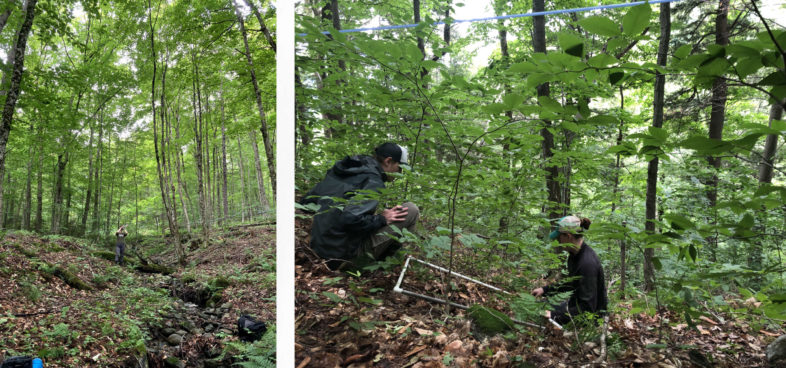
Left: Me using the laser hypsometer to estimate canopy height. © Steve Faccio
Right: Field tech Gordon Coates (left) and crew lead and PhD student Liza Morse (right), both of UVM, examine a one-by-one meter square to estimate cover of herbaceous plants, bryophytes, bare soil, ferns, and grasses. © Eileen Fitzgerald
The field work was never dull. Some days I worked on a large crew of lively forestry and wildlife students from UVM, measuring different facets of forest structure—from canopy to leaf litter. By looking at not only what trees exist in each sugarbush, but also prevalence of logs (“coarse woody material”), herbaceous plant cover, and sapling regeneration, we get a more complete picture of the habitat and what it might mean for different bird species found there.
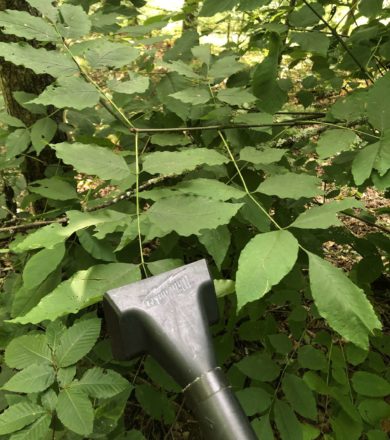
Vacuuming an ash tree: arthropod data collection or forest micromanagement? © Eileen Fitzgerald
Other days I walked alone through mapled hills with a battery-powered shop vac to suck up insects and estimate arthropod biomass—essentially, how many bugs are present. When doing this, I forgot how ludicrous I must look to passersby because there were none. However, what was never lost on me, even in mosquito swarms and sudden bursts of rain, was how incredible and complex these rich forests are and how lucky I am to spend my days in them.
My daily tête-à-tête with the forest—where I ask it what’s going on and rely on forestry tools to translate the answer—taught me that the forest itself is both question and answer. The more we learn about its functions and internal relationships, the more questions arise, providing a pathway to protect that which is so iconic to Vermont.
Bumblebee Surveys
I’m a vegetarian who doesn’t own a gun and cries during sad commercials. A “predator instinct” wasn’t a sensation that I was familiar with until I started surveying for bumblebees.
UVM/VCE’s perennial intern, Ani McMannon, and I equip ourselves with swing nets, glass vials, muck boots, and ineffective yet aromatic tick spray to trek along powerlines. We’re doing this as part of a study that seeks to understand bumblebee diversity along utility right-of-ways (ROW). ROW’s aren’t known for their aesthetic beauty, however they create unique habitats that support grassland arthropods I don’t usually encounter. While at first it’s challenging for me to not get distracted by all that calls the ROW home, I’m pure focus when the survey begins.
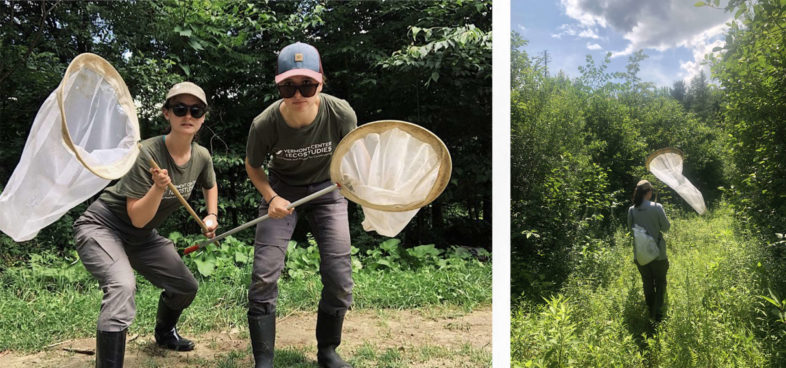
Left: Ani McMannon (right) and I geared up for a Bombus survey. © Eileen Fitzgerald
Right: Walking along a thick ROW transect. © Ani McMannon
On sunny days (one condition for bumblebee catching is the ability to see your shadow), we walk 200 meters along a transect of tall grass and wildflowers, meeting many spiders and raspberry thorns along the way. I scan surrounding grassy patches looking for an easy prey—Bombus, a notoriously slow and literally “bumbling” bee. They’re hard to miss, both in terms of sight and swing. These bees’ clumsy gait among wildflowers like milkweed, joe pye weed, vetch, jewelweed, and red clover betrays their intentions to feed and subsequently pollinate. Once one appears in my line of sight, I swing my net down, pinch off the net’s end, and carefully coax the now angry creature into a glass vial. I then put that vial on ice in a Coleman cooler designed for 6-packs. This freezes the bee into an icy but temporary coma, which ensures that we can photograph and identify each specimen before releasing it. With this method, we aren’t so much harming as temporarily inconveniencing it.

Bees awaken from a frozen slumber as we square away our data. © Eileen Fitzgerald
Sometimes we catch nothing, and other times we catch around 40 individuals on a single transect! The excitement of a catch and spirit of inquiry energizes me from site to site like a bee going from flower to flower (even when my Nissan Altima parked on the side of a dirt road would rather me go nowhere).
Loon Conservation
What is it about loons that captures people’s attention and hearts? What makes them both so charismatic and enigmatic? Whatever it is, it has helped secure their conservation status. Breeding pairs of Common Loons in Vermont have increased from seven to 96 pairs in the past 37 years. This is largely due to the tireless conservation efforts of people in organizations operating programs like VCE’s Vermont Loon Conservation Project.
In school, I learned a lot about conservation science and practice in classroom settings but working for VCE has shown me what this looks like on a day-to-day level. This summer, I occasionally joined VCE’s seasonal loon assistant, Eloise Girard, in between other projects. On those day, I helped with habitat raft removal, construction, and movement—some of the most hands-on conservation work I’ve ever done—as well as with loon and chick surveys.
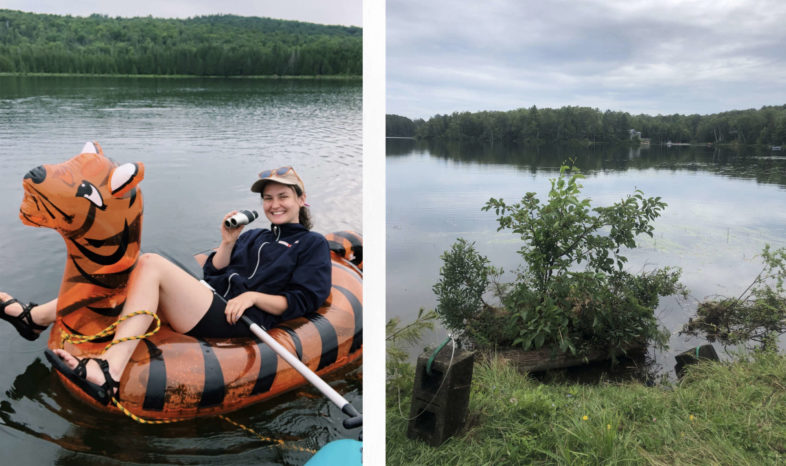
Left: Conducting loon surveys when you’re short a kayak makes improvising necessary. © Danny Mulkerin
Right: A floating habitat raft for Common Loons. © Eileen Fitzgerald
For lakes where geese and other shoreline hazards make nest establishment a challenge for loons, we create nesting space by anchoring floating rafts of sod and woody vegetation next to shore. They measure about four-by-four feet and are made of large cedar logs with wire mesh encasing foam between them. For some lakes we replaced existing older rafts, which meant towing a waterlogged behemoth behind our canoe.
Building rafts is dirty work, not unlike my occasional side-gig this summer of roof shingling. For both I used power tools, built a home, and sweated profusely. The difference is, when working with loons, I’m on some of the most beautiful lakes I’ve ever seen: calm gaps of cool deep blue nestled among green towers in Vermont’s Northeast Kingdom.
Playing even a small part in this work that has such clear and quantifiable results among populations of my favorite waterbird is amazing. Something I’ve most appreciated seeing this summer is all the volunteers who take time out of their day to help with rafts. It shows how effective conservation is also collaborative. Enough people throughout Vermont decided that Common Loons were worth conserving and worked to make it happen, proving how powerful dedicated people practicing community science can be.
Bird Banding on Mt. Mansfield
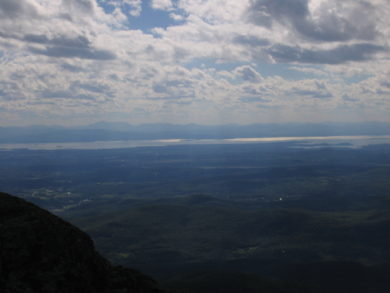
From peak to valley: the view of Lake Champlain from Mt. Mansfield. © Chuck Sokol
Gazing down on Lake Champlain, Vermont’s lowest point, from the highest point on Mount Mansfield gives me bone-deep senses of both appreciation and vertigo. It’s beautiful and, on a clear day, you can see the Adirondacks encasing Champlain’s opposing shore. However, this late afternoon in early August wasn’t a clear day. A blue-gray wall of haze hung heavy over the valley. It was smoke that rode prevailing winds from the burning West—an ominous reminder of why I’m up here. Climate change represents an existential threat to biodiversity on multiple fronts and studying and understanding that biodiversity is an essential part of mitigating its impact.
Despite the looming cloud, the mood at the top of Vermont was alight with curiosity and glee. VCE’s bird banding team and I are up here using nets to catch birds and accessorize them with identification bands and GPS backpacks. Throughout the summer, I was able to join this team of birders three times. During those three visits, I witnessed the capture of 134 birds. One of my favorite birds that we caught was the Blackpoll Warbler, a sleek, cute, but somewhat nondescript little warbler with a black cap and a serious knack for endurance sport. During migration, it flies from forests in Canada and Northeastern U.S. all the way to northern South America, east of the Andes Mountains. Included in this trip is a non-stop flight over the Atlantic, taking about three days. A creature that seems so small and fragile can carry itself over open waters to the Caribbean without a single stop, which really can put things into perspective. If challenges of oceanic scales can be overcome by this tiny warbler, can we not collectively rise to the mounting challenge that is conservation in the age of climate change? And can I not rise to the challenge of getting out of my tent at 4:00 AM to check on our nets?
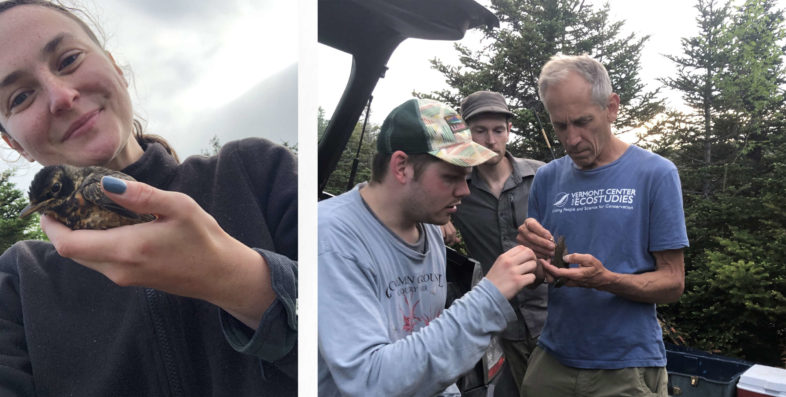
Left: Holding a young American Robin in hand was worth at least two in the bush. © Eileen Fitzgerald
Right: Kevin Tolan (left), Chris Hansen (middle), and Chris Rimmer (right) fit a GPS backpack to a Bicknell’s Thrush. © Eileen Fitzgerald
The people I worked with at VCE definitely know birds, from population ranges to feather lice and everything in between. Having access to this wealth of knowledge while being so hands-on makes the early wake-up feel much easier; I get to learn so much from them. Knowledge is power and effective conservation in the face of such challenges demands that power.
*****
Eileen Fitzgerald served as VCE’s 2021 Alexander Dickey Conservation Intern. She graduated from Siena College in May 2020 with a BS in Environmental Science and a concentration in Conservation Science. Eileen moved to Vermont in June 2021 and plans to remain in the state as an AmeriCorps member at the South Hero Land Trust this fall.
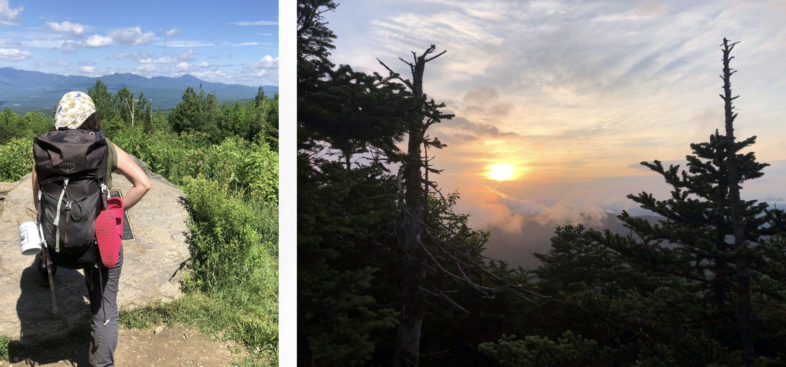
Left: Stopping to enjoy the view post-bird banding. © Eileen Fitzgerald
Right: Another stunning sunrise on Mt. Mansfield. © Eileen Fitzgerald

Eileen, thanks for your beautifully written, very informative and definitely entertaining account of the summer’s activities. As an old timer I came to love natural history late in life. Seeing the enthusiasm and excitement you have at the future ahead of you makes me smile and fills me with bitter-sweet thoughts of a different path I might have taken with my life. One comment you made struck me as so true: every new discovery we make, whether at the cutting edges of science or in our own personal quest for knowledge, inevitably opens up a whole new series of questions waiting to be answered.
As for what it is about loons that captures our imaginations, for me it happens late at night. When I take my dog Cinder out for a last walk in the yard before going to bed, she and I both pause and are carried far away by the long, haunting call of a loon on Mascoma Lake.
Best wishes for your next adventures at the South Hero Land Trust.
Thank you for this informative and brightly written tour of VCE’s wide ranging projects on behalf of our beautiful world! We will need Eileen and her young colleagues to shoulder great responsibilities in the face of so many challenges. Good luck!Veer Frost
So beautifully written! Ok so I’m Eileen’s mom. I share in her appreciation of the beauty of nature but I don’t share in her knowledge, and it was great to read here what she was doing all summer! I’m proud and so happy my daughter gets to have a job she loves and is passionate about and is for all our benefit. ❤️